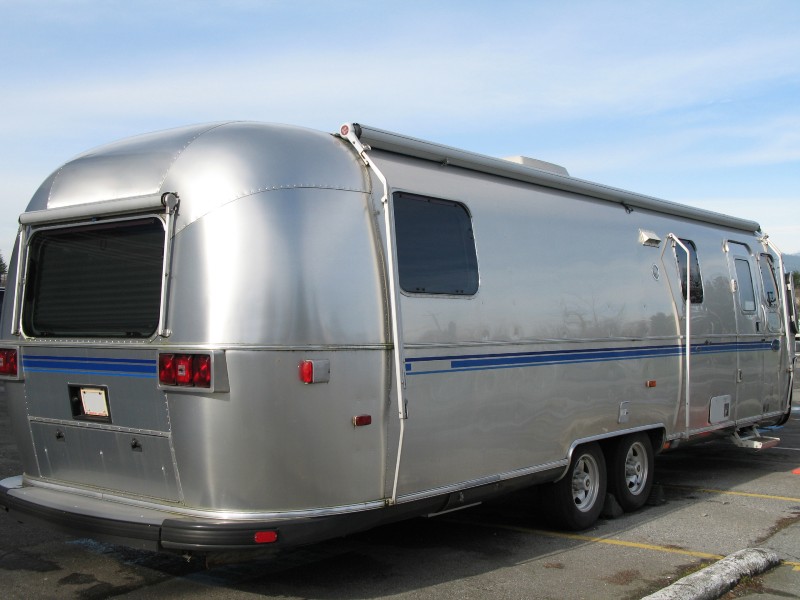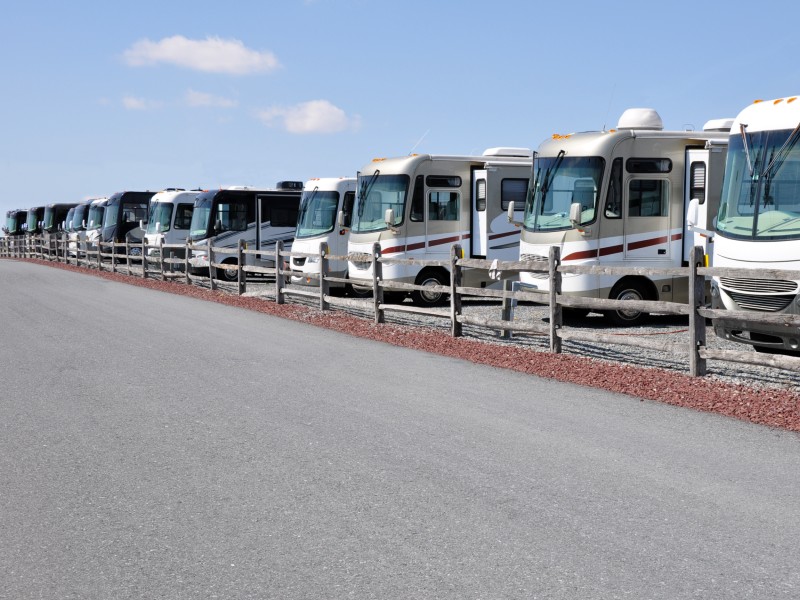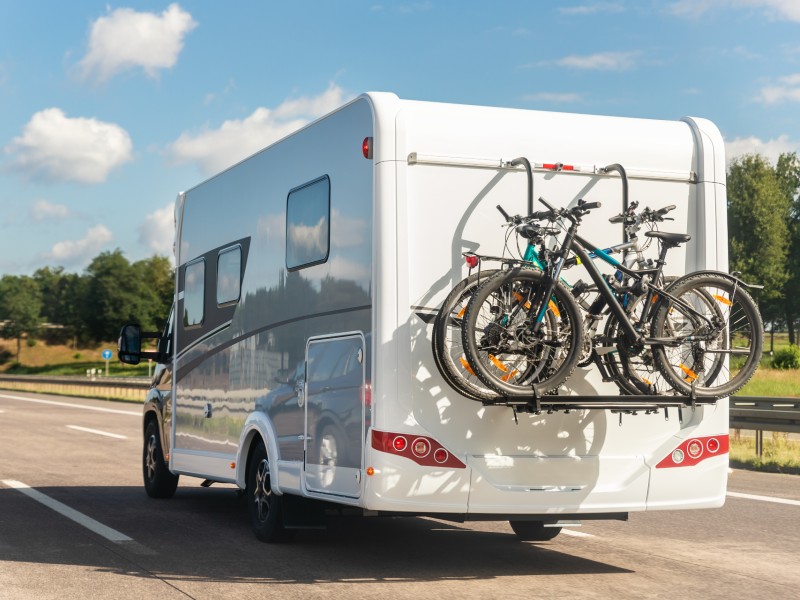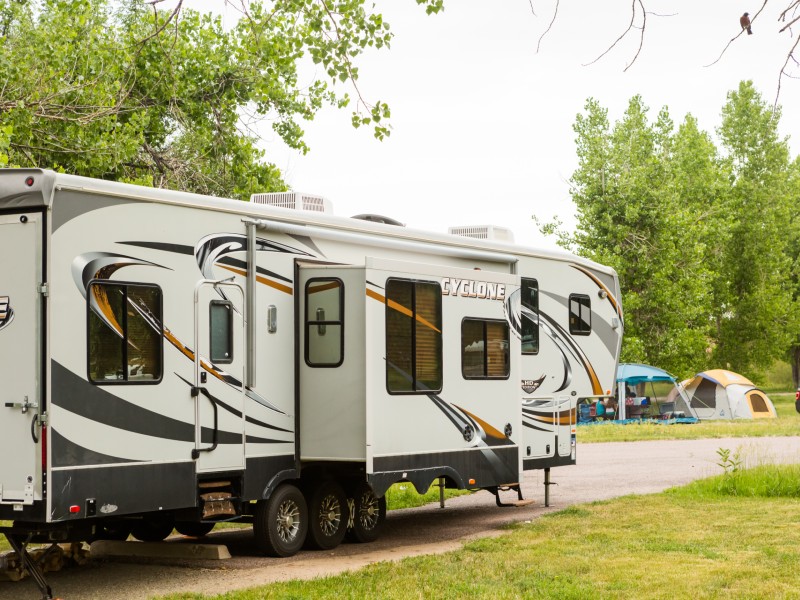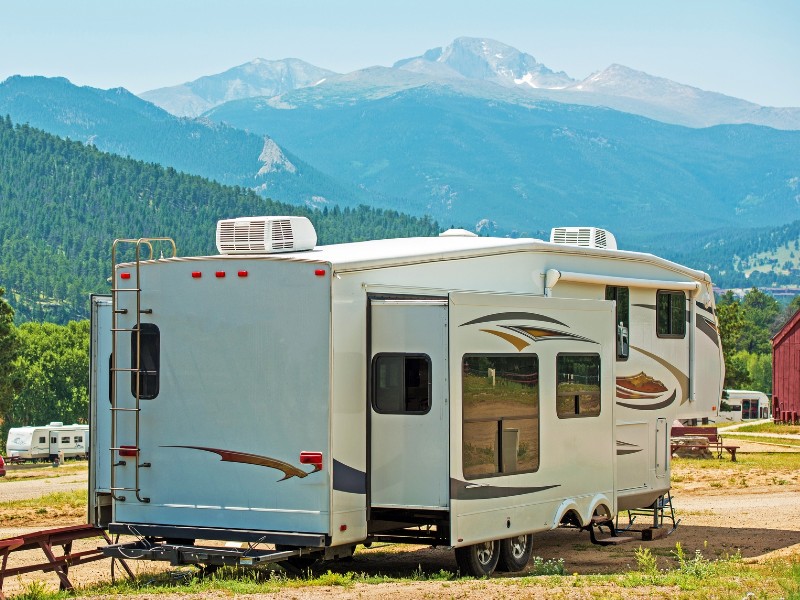If you love the rustic feel of camping in a fifth wheel but prefer the security of a motorhome, you might be wondering where to start. There are a seemingly endless variety and brands of motorhomes, and the decision-making process may seem overwhelming.
Perhaps you’ve heard of a Class C motorhome or are trying to decide between a self-contained motorhome or a tow-along model.
Different Types of Motorhomes
Recreational vehicles, or RVs, come in a variety of styles or types. There are Class A, Class B and Class C motorhomes to start.
Along with these self-contained models, there are also tow-along options as well. Travel trailers, folding and tent trailers and fifth wheels are all RVs that allow you to bring your truck or van along for the journey.
This article is going to get into detail about the differences, and similarities, between Class A motorhomes and fifth-wheel truck trailers. We will discuss various aspects such as fuel usage, livability and cost of maintenance, among other things.
Class A Motorhome
A Class A motorhome is defined as the biggest of the three self-contained motorhomes. Think of a band’s tour bus.
They can be between 21 and 45 feet long and can run on either diesel or regular fuel depending on the RV.
Fifth Wheel
A fifth wheel is a type of travel trailer, which is the most common type of RV. The term “fifth wheel” refers to the towing component found on the back of the towing vehicle (which is typically a pickup truck of some kind).
The primary benefit of a fifth wheel is that you can detach your vehicle from the RV to travel away from your campsite whenever you desire.
Here are some aspects you will want to consider when deciding between a Class A motorhome and a fifth-wheel RV as well as some of the benefits and disadvantages that come with each.
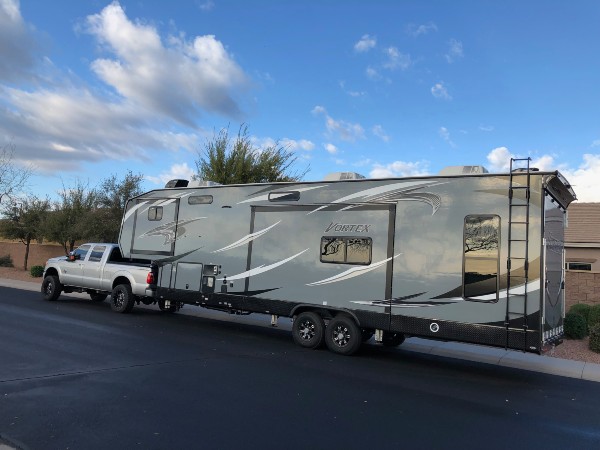
Setup and Leveling
Once you reach a campsite you may think you’re ready to begin hiking, fishing or whatever else you had planned. An RV needs to be set up just like any other campsite.
First, you have to level your camper so that it is secure on all sides from the possibility of rolling during use.
While both Class A and fifth-wheel RVs tend to have automatic, as opposed to manual, leveling mechanisms, the fifth wheel may be easier to use as the jack used to attach the fifth wheel to your vehicle has a wider range of motion than most Class As.
After your RV is leveled you need to put out your sliders. Sliders are pop-out areas of an RV that lends more living space when the RV is not in travel.
Typically, sliders tend to be narrower in a motorhome than a fifth wheel because people want to be able to move around in the motorhome while it is on the road.
Because fifth wheels don’t have passengers while on the road, they can have larger slides that can prevent getting in the fifth wheel until the slides are out.
The decision here lies in whether you would prefer to live in your RV with more space while it is traveling, or if you are fine towing the RV along and only living in it when it is parked and the slides are pulled out.
Storage
While both styles of RVs have significant storage, there are differences in where the storage may be and whether it is accessible from inside or outside the home. The reason is that both types can vary in length which is going to be a factor.
Assuming the RVs are roughly the same length, Class A motorhomes tend to have more carrying capacity with storage space both in and underneath the home itself.
However, when considering a fifth wheel, you can also take into account the extra storage space that your towing vehicle will allow as well. There is also the consideration that the slides of a fifth wheel tend to be wider which allows for more storage space potential.
When considering between the two, the decision ultimately comes down to personal preference. Because both Class A and fifth wheels have comparable storage space, you will have to look around and find out what would work best for your needs.
Whether you are traveling with family and want everything close by, a Class A may be more helpful in that regard. However, if you prefer to hunt and fish and don’t need to keep your gear in the same area where you eat and sleep, you might be better off with a fifth wheel.
Utilities
You will need gas and water to provide you with warm water, heat and cooking in your RV. Many Class A motorhomes have large propane tanks attached to their chassis.
The disadvantage here is that the tank can be hard to refill since it is attached to the RV itself. Generally, you will have to find a place that not only refills propane but can allow your large Class A into the parking lot.
This can be difficult and time-consuming.
Fifth wheels on the other hand usually have smaller propane tanks that can be removed and transported or replaced for refilling.
Water is the other utility you want to take into account when considering the differences between these two types of RVs. Class A vehicles have larger freshwater tanks as well as grey and black water tanks.
If you are hoping to get by longer before having to empty or refill your tanks, Class A would be a better option. If emptying and refilling your tanks is less of a concern, the fifth wheel may hold less of each but can have other benefits that make it worthwhile.
Sleeping Space
Because fifth wheels generally have more living space than motorhomes of the same length, there is likely to be room to fit more people into a fifth wheel than a Class A motorhome.
Motorhomes have to include the engine, driver and passenger seats and other vehicle accouterments, whereas a fifth wheel of the same length can be entirely living space.
Fifth wheels tend to have a master bedroom over the hitch and with the possibility of slide-outs and how you want to allocate your living space, most of that space can be exclusively or jointly shared with other areas.
For instance, a dining area can easily be turned into an extra bed in most models of RVs.
Master bedrooms are usually in the back of Class A motorhomes, and while the master bedrooms are usually the same size as in fifth wheels if you are looking for extra bed space for your family, it is less likely to have bunk rooms in Class A motorhomes.
Though not unlikely. Again, the decision comes down to personal preference.
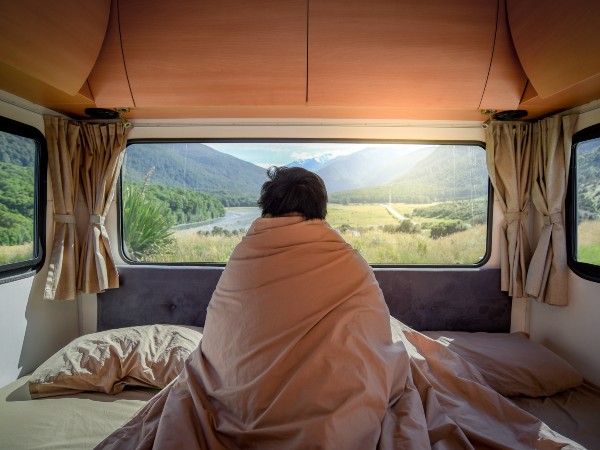
Long Distance Traveling
Both types of recreational vehicles are fit for long-distance travel which means this category has more to do with how you wish to live while you travel. If you don’t mind a long car ride with no easy access to your personal belongings then a fifth wheel will work for you.
On long-distance rides, it is typical not to use the fifth wheel until you’ve reached your destination for the evening.
The disadvantage here is that, if you have something packed in the RV that you want to access, you have to wait until you are in a position to park and pull the slides out before reaching your belongings.
With a Class A motorhome, however, your belongings are all in one space with you while you travel.
You would potentially be able to access your closets, bedroom(s) or even your bathroom while the vehicle is still in a road-ready condition.
If you prefer to be around your home and your belongings while you travel, a Class A motorhome would be preferable. If you don’t mind waiting to access your gear until you’ve settled into camp then a fifth wheel would work just fine.
Explore the Great Outdoors with Us!
Exploring
This category lends a huge advantage to the fifth wheel. While your day-to-day living may be carried out in your RV, there are going to be times when you will want to leave camp, whether to visit a historical landmark or even just to head out for groceries.
Because a fifth wheel attaches to your car or truck, it can be easily detached so that you can use your everyday vehicle for getting around whatever city you are exploring.
Though it is possible to tow a car along behind a Class A motorhome, this adds not only weight to your travel, which will increase gas mileage, but it also adds length to your vehicle that may require practice navigating before you head out on your first adventure.
If you are an adventurous person or family who prefers to explore the city surrounding your campsite while still having a base camp to return to, the fifth wheel is by far the best option.
If you are leaning more towards a Class A you should take into account whether you will tow an everyday car behind your RV or if you wouldn’t mind driving such a large vehicle every time you needed to stop for groceries or visit a tourist site.
Cost of Maintenance
Maintenance costs are comprised of a number of factors. This can include gas costs but we’ll cover that in another section.
The maintenance costs you should consider include:
- Oil changes: Class A motorhomes require regular oil changes much like any vehicle. Unfortunately, oil changes for such a large vehicle can cost hundreds of dollars. You would not have this problem with a fifth wheel as you would only have to change the oil on your towing vehicle as usual.
- Insurance costs: Insurance costs for a fifth wheel are slightly less expensive than a Class A motorhome because they don’t drive and so there is no worry about vehicle collisions and there are fewer chances of a fifth wheel breaking down than a Class A. A fifth wheel will require insurance on top of your usual car insurance, however, so that should be taken into consideration.
- Repairs: Generally repairs will cost less for a fifth wheel for the simple fact that there are fewer things that could go wrong with a fifth wheel. With a Class A RV, you have the possibility of engine maintenance as well as living space maintenance. With a fifth wheel, you eliminate the necessity for engine maintenance and can focus your attention more closely on the upkeep of your home.
These costs can vary greatly depending on the size of your RV and whether you choose a Class A or a fifth wheel. Keep in mind that if you choose a Class A motorhome and opt to tow a car along with you, that is multiple insurances, oil changes, engine maintenance and more.
Many of these maintenance costs are not an issue with most fifth wheels.
Living Space
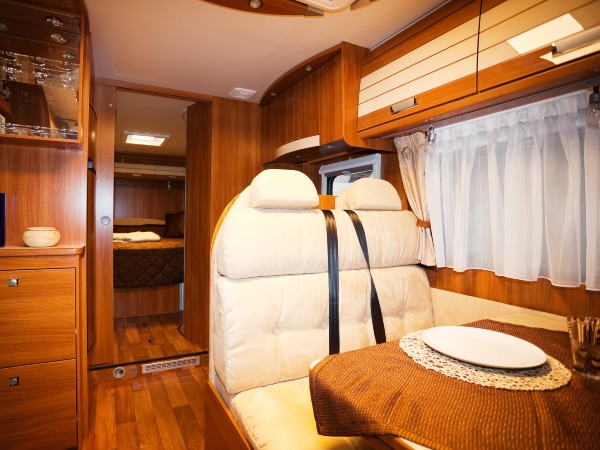
Much like sleeping space, the space in which you live is almost equally important. If you want to be able to live comfortably in your recreational vehicle, you will want to consider amenities with regard to your living situation.
Aside from sleeping areas, an RVs most important features are the kitchen and dining area as well as bathrooms. If you prefer a larger kitchen, you may be more willing to downgrade your bathroom space to a wet bath where the shower is shared in the same area as the toilet.
If you prefer a bathroom with a separate shower and vanity, you might be willing to give up your dining area.
Depending on size and layout both Class A motorhomes and fifth-wheel trailers can accommodate many lifestyle choices. Fifth wheels, since they generally have larger slide-outs, generally have larger kitchen spaces, often with a kitchen island for extra counter space.
Class A motorhomes tend to focus more on living room style areas or bedroom areas more than kitchens.
Decide what sort of living space you’d prefer before beginning your search or the seemingly endless possibilities can be overwhelming.
Take Off Time
This is the time it takes you from start to finish to pack up your camp and head out with your RV.
A Class A motorhome can be a lot easier to pack up than a fifth wheel since there is no vehicle to have to hitch to. Because Class A is a self-contained vehicle you simply pull in your slide-outs and you are more or less ready to go.
Of course, both types require you to empty your grey and black water tanks from time to time as well. Class A has the benefit here too, as the tanks in Class A motorhomes are generally larger than they are on fifth wheels.
The only thing that may take more time with a Class A vehicle is if you tow along a car to travel within the cities you visit. In that case, you must allow extra time for hitching the car to the motorhome.
Fuel Economy
One of the most frequently asked questions about the difference between recreational vehicles has to do with fuel usage/cost per gallon and costs. Unfortunately, there is no concrete answer to this question.
Some people boast that their fifth wheel gets better miles per gallon than a Class A motorhome, while others say their Class A has better mileage.
There are contributing factors such as how much you are carrying with you on your voyages, whether you intend to tow a car behind your Class A, how good your towing vehicle’s mileage is, whether you are running on diesel or regular fuel and other aspects as well.
Generally, you can find a rough idea of miles per gallon when looking at the specifications of a recreational vehicle. Just be sure to take into account whether you intend to tow a vehicle before you settle on a Class A being better with fuel.
Conclusion
These are the primary aspects to consider when considering the differences between a Class A motorhome and a fifth wheel. Of course, your personal preference will come into play when choosing what is right for you.
There is always the possibility of renting before you buy as well. If you are trying to recognize the difference between two styles of RV and which you would prefer, try renting one for a weekend camping getaway to get a feel for what your preferences might be.
You may be surprised to find that you enjoy the ability to detach your truck from your RV in order to go exploring. Or you may enjoy the convenience of having your home and your vehicle be the same thing.
The most important thing to remember is to do proper research and test drives or rentals before deciding what is right for you.
Related Questions
- What are the main differences in setup and leveling between a Class A motorhome and a fifth-wheel RV?
The main differences in setup and leveling between a Class A motorhome and a fifth-wheel RV lie in their construction and mobility.
Class A motorhomes are self-contained units built on a chassis, while fifth-wheel RVs require a separate towing vehicle and are connected to it using a hitch, necessitating leveling procedures for stability.
- How does storage capacity compare between Class A motorhomes and fifth-wheel RVs?
Class A motorhomes generally offer more built-in storage capacity due to their larger size and integrated design, allowing for more compartments and spaces for belongings.
However, the storage capacity in fifth-wheel RVs can vary greatly based on size and design, and while typically less than Class A motorhomes, can be more efficiently organized due to their segmented layout.
- What are the differences in utility management, such as gas and water, between Class A motorhomes and fifth-wheel RVs?
Class A motorhomes generally feature a more comprehensive and integrated utility management system, including built-in water, gas, and sewage systems, due to their larger size and self-contained design.
On the other hand, fifth-wheel RVs often rely on hookups at campgrounds for water and sewage and may have smaller, portable propane tanks for gas, providing flexibility but requiring more hands-on management.
- How does sleeping space and living area compare between Class A motorhomes and fifth-wheel RVs?
Class A motorhomes tend to offer more overall living space, featuring larger common areas and sometimes additional amenities like washing machines or larger kitchens.
Fifth-wheel RVs, while generally more compact, provide more separated living areas and often have a larger sleeping capacity due to their multi-level design.
- What are the considerations for long-distance traveling in a Class A motorhome versus a fifth-wheel RV?
Class A motorhomes offer the advantage of seamless mobility and comfort since they contain the living quarters and driver’s area in one unit, but they may be more challenging to maneuver and park due to their size.
On the other hand, fifth-wheel RVs, while needing a separate towing vehicle, often offer more living space and stability and are easier to detach for local trips, but they require more effort in setting up at each location.
"Of all the paths you take in life, make sure a few of them are dirt."
-- John Muir
